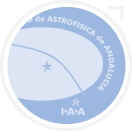The Mars Climate Database (MCD version 5.2)
European Planetary Science Congress 2015
August, 2015
ABSTRACT
The challenge and scientific application of the CO2 4.3 um atmospheric limb emission of Mars
European Planetary Science Congress 2015
September, 2015
ABSTRACT
The Martian ionosphere: comparison of a global climate model with MARSIS data
European Planetary Science Congress 2015
September, 2015
ABSTRACT
UPWARDS: An integral study of Mars in preparation for Exomars
IV Reunión de Ciencias Planetarias y Exploración del Sistema Solar. Alicante, Spain, 2015. (Oral)
May, 2015
ABSTRACT
CO2 non-LTE limb emissions in Mars' atmosphere as observed by OMEGA/Mars Express
June, 2016
ABSTRACT We report on daytime limb observations of Mars upper atmosphere acquired by the OMEGA instrument on board the European spacecraft Mars Express. The strong emission observed at 4.3m is interpreted as due to CO2 fluorescence of solar radiation and is detected at a tangent altitude in between 60 and 110km. The main value of OMEGA observations is that they provide simultaneously spectral information and good spatial sampling of the CO2 emission. In this study we analyzed 98 dayside limb observations spanning over more than 3 Martian years, with a very good latitudinal and longitudinal coverage.... read more
Variability of the Martian thermosphere during eight Martian years as simulated by a ground-to-exosphere global circulation model
November, 2015
ABSTRACT Using a ground-to-exosphere general circulation model for Mars we have simulated the variability of the dayside temperatures at the exobase during eight Martian years (MY, from MY24 to MY31, approximately from 1998 to 2013), taking into account the observed day-to-day solar and dust load variability. We show that the simulated temperatures are in good agreement with the exospheric temperatures derived from Precise Orbit Determination of Mars Global Surveyor. We then study the effects of the solar variability and of two planetary-encircling dust storms on the simulated temperatures. The... read more
Characterization of dust activity from Martian Year (MY) 27 to MY 32 observed by the Planetary Fourier Spectrometer aboard the Mars Express spacecraft
January, 2016
ABSTRACT More than 2,500,000 spectra have been collected by the Planetary Fourier Spectrometer aboard Mars Express spacecraft after 12 years of activity. The data span more than six Martian years, from MY26, Ls = 331, to MY 33, Ls = 78. This huge dataset has been used to build a new database of atmospheric parameters, including atmospheric and surface temperatures, and dust and water ice opacity. Dust aerosols suspended in the atmosphere affect its thermal structure and are a major driver of the circulation. They are always present in the Martian atmosphere, but the amount varies greatly depending on... read more
Mars EXpress: status and recent findings
Geophysical Research Abstracts Vol. 18, EGU2016-14576, 2016 EGU General Assembly 2016
January, 2016
ABSTRACT Mars Express has entered its second decade in orbit in excellent health. The mission extension in 2015-2016 aims at augmenting of the surface coverage by imaging and spectral imaging instruments, continuing monitoring of the climate parameters and their variability, study of the upper atmosphere and its interaction with the solar wind in collaboration with NASA’s MAVEN mission. Characterization of geological processes and landforms on Mars on a local-to-regional scale by HRSC camera constrained the martian geological activity in space and time and suggested its episodicity. Six years of... read more
12 years of atmospheric monitoring by the Planetary Fourier Spectrometer onboard Mars Express
Geophysical Research Abstracts Vol. 18, EGU2016-8609, 2016 EGU General Assembly 2016
January, 2016
ABSTRACT We use thermal-infrared spectra returned by the Mars Express Planetary Fourier Spectrometer (PFS-MEx) to retrieve atmospheric and surface temperature, and dust and water ice aerosol optical depth. More than 2,500,000 spectra have been used to build this new dataset, covering the full range of season, latitude, longitude, and local time. The data presented here span more than six Martian years (from MY26, Ls = 331, 10 January 2004 to MY 33, Ls = 78, 6 December 2015). We successfully retrieved atmospheric temperatures and aerosols opacity in the polar regions, including the polar nights. By... read more
Mesospheric CO2 ice clouds on Mars observed by Planetary Fourier Spectrometer onboard Mars Express
Geophysical Research Abstracts Vol. 18, EGU2016-8330, 2016 EGU General Assembly 2016
January, 2016
ABSTRACT We investigate mesospheric CO2 ice clouds on Mars detected by the Planetary Fourier Spectrometer (PFS) onboard Mars Express (MEx). The relatively high spectral resolution of PFS allows firm identification of the clouds’ reflection spike. A total of 279 occurrences of the CO2 ice clouds features has been detected at the bottom of 4.3 m CO2 band from the MEx/PFS data during the period from MY27 to MY32. 115 occurrences out of them are also confirmed by simultaneous observations by MEx/OMEGA imaging spectrometer. The spatial and seasonal distributions of the CO2 ice clouds observed by PFS are... read more
Modeling infrared thermal emissions on Mars during dust storm of MY28: PFS/MEX observation
41st COSPAR Scienti
c Assembly 2016
January, 2016
ABSTRACT We have analysed thermal emission spectra obtained from Planetary Fourier Spectrometer (PFS) onboard Mars Express (MEX) for Martian Year (MY) 28 in presence and absence of dust storm at low latitude. A radiative transfer model for dusty atmosphere of Mars is developed to estimate the thermal emission spectra at latitude range 0-10oS, 10-20oS and 20-30oS. These calculations are made at Ls=240o, 280o, 300o, and 320o between wave numbers 250-1400 cm-1. We have also retrieved brightness temperatures from thermal emission spectra by inverting the Planck function. The model reproduces the observed... read more
The solsticial pause on Mars: 2 modelling and investigation of causes
January, 2016
ABSTRACT The Martian solsticial pause, presented in a companion paper (Lewis et al., 2016), was investigated further through a series of model runs using the UK version of the LMD/UK Mars Global Climate Model. It was found that the pause could not be adequately reproduced if radiatively active water ice clouds were omitted from the model. When clouds were used, along with a realistic time-dependent dust opacity distribution, a substantial minimum in near-surface transient eddy activity formed around solstice in both hemispheres. The net effect of the clouds in the model is, by altering the thermal... read more
Science objectives and performances of NOMAD, a spectrometer suite for the ExoMars TGO mission
December, 2015
ABSTRACT The NOMAD spectrometer suite on the ExoMars Trace Gas Orbiter will map the composition and distribution of Mars' atmospheric trace species in unprecedented detail, fulfilling many of the scientific objectives of the joint ESA-Roscosmos ExoMars Trace Gas Orbiter mission. The instrument is a combination of three channels, covering a spectral range from the UV to the IR, and can perform solar occultation, nadir and limb observations. In this paper, we present the science objectives of the instrument and how these objectives have influenced the design of the channels. We also discuss the expected... read more
The physics of Martian weather and climate: a review
December, 2015
ABSTRACT The planet Mars hosts an atmosphere that is perhaps the closest in terms of its meteorology and climate to that of the Earth. But Mars differs from Earth in its greater distance from the Sun, its smaller size, its lack of liquid oceans and its thinner atmosphere, composed mainly of CO2. These factors give Mars a rather different climate to that of the Earth. In this article we review various aspects of the Martian climate system from a physicist’s viewpoint, focusing on the processes that control the Martian environment and comparing these with corresponding processes on Earth. These include... read more
The Imaging Ultraviolet Spectrograph (IUVS) for the MAVEN Mission
December, 2015
ABSTRACT The Imaging Ultraviolet Spectrograph (IUVS) is one of nine science instruments aboard the Mars Atmosphere and Volatile and EvolutioN (MAVEN) spacecraft. MAVEN, launched in November 18, 2013 and arriving at Mars in September 2014, is designed to explore the planet's upper atmosphere and ionosphere and examine their interaction with the solar wind and solar ultraviolet radiation. IUVS is one of the most powerful spectrographs sent to another planet, with several key capabilities: (1) separate Far-UV & Mid-UV channels for stray light control, (2) a high resolution echelle mode to resolve... read more
ACS experiment for atmospheric studies on "ExoMars-2016" Orbiter
December, 2015
ABSTRACT ACS is a set of spectrometers for atmospheric studies (Atmospheric Chemistry Suite). It is one of the Russian instruments for the Trace Gas Orbiter (TGO) of the Russian-European "ExoMars" program. The purpose of the experiment is to study the Martian atmosphere by means of two observations regimes: sensitive trace gases measurements in solar occultations and by monitoring the atmospheric state during nadir observations. The experiment will allow us to approach global problems of Mars research such as current volcanism, and the modern climate status and its evolution. Also, the experiment is... read more
Seasonal variation of the HDO/H2O ratio in the atmosphere of Mars at the middle of northern spring and beginning of northern summer
November, 2015
ABSTRACT We present the seasonal variation of the HDO/H2O ratio caused by sublimation-condensation processes in a global view of the Martian water cycle. The HDO/H2O ratio was retrieved from ground-based observations using high-dispersion echelle spectroscopy of the Infrared Camera and Spectrograph (IRCS) of the Subaru telescope. Coordinated joint observations were made by the Planetary Fourier Spectrometer (PFS) onboard Mars Express (MEX). The observations were performed during the middle of northern spring (Ls = 52°) and at the beginning of summer (Ls = 96°) in Mars Year 31. The retrieved... read more
Unique Spectroscopy and Imaging of Mars with JWST
October, 2015
ABSTRACT In this document, we summarize the main capabilities of the James Webb Space Telescope (JWST) for performing observations of Mars. The distinctive vantage point of JWST at the Sun-Earth Lagrange point (L2) will allow sampling the full observable disk, permitting the study of short-term phenomena, diurnal processes (across the East-West axis) and latitudinal processes between the hemispheres (including seasonal effects) with excellent spatial resolutions (0.07 arcsec at 2 {\mu}m). Spectroscopic observations will be achievable in the 0.7-5 {\mu}m spectral region with NIRSpec at a maximum... read more
Sulfur in the early Martian atmosphere revisited: Experiments with a 3-D Global Climate Model
November, 2015
ABSTRACT Volcanic SO2 in the Martian atmosphere has been invoked as a way to create a sustained or transient greenhouse during early Martian history. Many modeling studies have been performed to test the feasibility of this hypothesis, resulting in a range of conclusions, from highly feasible to highly improbable. In this study we perform a wide range of simulations using the 3-D Laboratoire de Météorologie Dynamique Generic Global Climate Model (GCM) in order to place earlier results into context and to explore the sensitivity of model outcomes to parameters such as SO2 mixing ratio, atmospheric H2O... read more
CO2-driven formation of gullies on Mars
November, 2015
ABSTRACT Since their discovery by the Mars Observer Camera, Martian gullies have attracted considerable attention because they resemble terrestrial debris flows formed by the action of liquid water. This interpretation is now questioned by the discovery of ongoing gully formation occurring in conditions much too cold for liquid water, but with seasonal CO2 frost present and defrosting. However, how a relatively thin seasonal dry ice cover could trigger the formation of decameter large debris flows exhibiting levees and sinuosities as if they were liquid-rich remained mysterious. We have developed an... read more
A solar escalator on Mars: Self-lifting of dust layers by radiative heating, Geophysical Research Letters
September, 2015
ABSTRACT Dust layers detected in the atmosphere of Mars by the light detection and ranging (LIDAR) instrument on the Phoenix Mars mission are explained using an atmospheric general circulation model. The layers were traced back to observed dust storm activity near the edge of the north polar ice cap where simulated surface winds exceeded the threshold for dust lifting by saltation. Heating of the atmospheric dust by solar radiation caused buoyant instability and mixing across the top of the planetary boundary layer (PBL). Differential advection by wind shear created detached dust layers above the PBL... read more
Laboratory Observations of Mass Wasting Triggered by Sublimation of Condensed CO2 Frost Under Martian Conditions
March, 2015
ABSTRACT Laboratory experiments examining the potential role of CO2 sublimation in Martian gully evolution.
Analysing the consistency of Martian methane observations by investigation of global methane transport
September, 2015
ABSTRACT Reports of methane on Mars at different times imply varying spatial distributions. This study examines whether different observations are mutually consistent by using a global circulation model to investigate the time evolution of methane in the atmosphere. Starting from an observed plume of methane, consistent with that reported in 2003 from ground-based telescopes, multiple simulations are analysed to investigate what is required for consistency with an inferred methane signal from the Thermal Emission Spectrometer made 60 sols later. The best agreement between the existing observations is... read more
The solsticial pause on Mars: 1. A planetary wave reanalysis
January, 2015
ABSTRACT Large-scale planetary waves are diagnosed from an analysis of profiles retrieved from the Thermal Emission Spectrometer aboard the Mars Global Surveyor spacecraft during its scientific mapping phase. The analysis is conducted by assimilating thermal profiles and total dust opacity retrievals into a Mars global circulation model. Transient waves are largest throughout the northern hemisphere autumn, winter and spring period and almost absent during the summer. The southern hemisphere exhibits generally weaker transient wave behaviour. A striking feature of the low-altitude transient waves in... read more
An extremely high-altitude plume seen at Mars' morning terminator
February, 2015
ABSTRACT The Martian limb (that is, the observed `edge' of the planet) represents a unique window into the complex atmospheric phenomena occurring there. Clouds of ice crystals (CO2 ice or H2O ice) have been observed numerous times by spacecraft and ground-based telescopes, showing that clouds are typically layered and always confined below an altitude of 100 kilometres suspended dust has also been detected at altitudes up to 60 kilometres during major dust storms. Highly concentrated and localized patches of auroral emission controlled by magnetic field anomalies in the crust have been observed at an... read more
Variability of the hydrogen in the Martian upper atmosphere as simulated by a 3D atmosphere-exosphere coupling
January, 2015
ABSTRACT We present the temporal variability of the atomic and molecular hydrogen density derived from a 3D General Circulation Model describing the Martian atmosphere from the surface to the exobase. A kinetic exospheric model is used to compute the hydrogen density above the exobase. We use these models to study the diurnal and seasonal variations of the hydrogen density and the Jeans escape rate as well as their variations with solar activity, assuming a classic dust scenario. We find that the diurnal variations of the hydrogen density are important with a peak in the dawn region during equinoxes... read more
Numerical modelling of the transport of trace gases including methane in the subsurface of Mars
April, 2015
ABSTRACT We model the transport of gas through the Martian subsurface in order to quantify the timescales of release of a trace gas with a source at depth using a Fickian model of diffusion through a putative Martian regolith column. The model is then applied to the case of methane to determine if diffusive transport of gas can explain previous observations of methane in the Martian atmosphere. We investigate which parameters in the model have the greatest effect on transport timescales and show that the calculated diffusivity is very sensitive to the pressure profile of the subsurface, but relatively... read more
Search for hydrogen peroxide in the Martian atmosphere by the Planetary Fourier Spectrometer onboard Mars Express
January, 2015
ABSTRACT We searched for hydrogen peroxide (H2O2) in the Martian atmosphere using data measured by the Planetary Fourier Spectrometer (PFS) onboard Mars Express during five Martian years (MY27-31). It is well known that H2O2 plays a key role in the oxidizing capacity of the Martian atmosphere. However, only a few studies based on ground-based observations can be found in the literature. Here, we performed the first analysis of H2O2 using long-term measurements by a spacecraft-borne instrument. We used the ν4 band of H2O2 in the spectral range between 359 cm-1and 382 cm-1 where strong features of H2O2... read more
Removal of atmospheric features in near infrared spectra by means of principal component analysis and target transformation on Mars: I. Method
June, 2015
ABSTRACT The aim of this work is to extract the surface contribution in the Martian visible/near-infrared spectra removing the atmospheric components by means of Principal Component Analysis (PCA) and target transformation (TT). The developed technique is suitable for separating spectral components in a data set large enough to enable an effective usage of statistical methods, in support to the more common approaches to remove the gaseous component. In this context, a key role is played by the estimation, from the spectral population, of the covariance matrix that describes the statistical correlation... read more
Cooling of the Martian thermosphere by CO2 radiation and gravity waves: An intercomparison study with two general circulation models
May, 2015
ABSTRACT Observations show that the lower thermosphere of Mars (∼100–140 km) is up to 40 K colder than the current general circulation models (GCMs) can reproduce. Possible candidates for physical processes missing in the models are larger abundances of atomic oxygen facilitating stronger CO2 radiative cooling and thermal effects of gravity waves. Using two state-of-the-art Martian GCMs, the Laboratoire de Météorologie Dynamique and Max Planck Institute models that self-consistently cover the atmosphere from the surface to the thermosphere, these physical mechanisms are investigated. Simulations... read more































